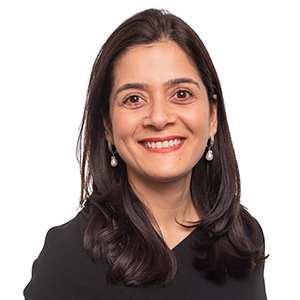A Conversation With Tanuj Kapilashrami

Tanuj Kapilashrami
Group Head of Human Resources for Standard Chartered Bank
CliftonStrengths Top 5: Achiever | Learner | Individualization | Self-Assurance | Arranger
Tanuj Kapilashrami, Group Head of Human Resources at Standard Chartered Bank, has an unusually modern view of human resources: "In HR, we're actually product managers," she says. "And employment is our product."
That view led Kapilashrami's HR organization to launch a host of innovations at the 85,000-employee, 59-market bank. They set a consumer-grade standard for internal tech, launched an Employee Experience Council with Standard Chartered's CTO to examine every touchpoint of the employee experience, piloted an internal gig economy, and began shifting the narrative of management from rules-based oversight to a principles-based dynamic.
Behind all the innovations, in ways big and small, is technology. Kapilashrami doesn't buy the notion that tech is dehumanizing -- just the opposite. "Our strong point of view is that as machines get better at being machines, humans can get better at being humans," she says. "The real magic happens when technology and humans come together."
Achieving that magic requires tech deployments based on data-driven, research-backed decisions. Indeed, the right decisions about the right tech deployed the right way "can make workplaces far more inclusive, far less hierarchical, and get the best discretionary effort out of the workforce," Kapilashrami explains in this CHRO Conversation. "And we've found that it opens up some extraordinary opportunities."
Emond: You told me something really interesting at a CHRO Roundtable once -- that we're the first generation that can say the technology we experience in our personal lives is better than our technology at work. Why does that matter?
Kapilashrami: When employees have much better technology at home than they can get at work, it turns your aspiration to be an innovative, client-obsessed business on its head. If you're competing for talent, especially on the digital side, and people's work experience is not in line with what they experience as consumers, they're going to walk away. And in HR, we're actually product managers. And employment is our product. We need the same thinking and techniques for our employment product that our product design teams deploy for consumer or client needs. Because companies that have a strong employee experience outperform companies that don't, and the employee experience in the most consumer-obsessed companies in the world is increasingly strong. So you have to ask, who is the custodian of that employee experience in the company? Who is responsible for curating it?
"If you're competing for talent, especially on the digital side, and people's work experience is not in line with what they experience as consumers, they're going to walk away."
Emond: Do you have HR employees who are true product design people, not HR people?
Kapilashrami: Yes. The head of my employee experience team has a strong background in product design, not financial services. You don't need a massive group for this -- my core team is about 20, and in some cases, we've bought additional help or borrowed it internally. But we've got that discipline in all the work we do. We did big tech deployments when we were all on lockdown and the tech and SME teams were all working from home in Chennai, Bangalore and Tianjin. With the right technology deployed the right way, you're not just improving the employee experience; you're unlocking productivity in the company. That's one reason our chief technology officer and I co-created our Employee Experience Council. We chair a forum comprised of all relevant stakeholders at Standard Chartered who are responsible for all the touchpoints that impact an employee's life in the workplace. We think about the employee experience very holistically, and this forum gives us a way to look at risk management versus employee experience and client needs.
Emond: How so?
Kapilashrami: For instance, we piloted an internal marketplace with over 12,000 colleagues in India a year ago. So, say you need a few hours a week of DEI expertise or a few hours a week of data skills -- a piece of work that will help serve our clients better. In a traditional organization, you'd have to go to your boss, write a proof of concept, ask for the resource, wait for approval -- all that delay. With this gig economy pilot, you post the spec or crowdsource it internally. If I have that expertise, I can take your gig.
There was huge skepticism that it would work. People said, "If Tanuj signs up for Larry's gig, does she get more money?" No. "Does Tanuj get credit for that in her scorecard?" No. "Does Tanuj get a bonus?" No. "Does Tanuj need her manager's signoff?" No. "Then why would anyone do it?" We knew people would do it because we have a huge amount of research on what our employees value in our employment proposition. We know our colleagues join us and stay with us for career development, growth and the opportunity to make an impact. Those qualities rank as high, and sometimes higher, than money. This project was based on that insight. We had 12,000 colleagues able to access the platform, all of them working remote, hundreds of projects posted … and in six months, we unlocked 4,000 hours of productivity. We were able to respond to critical pieces of work quickly, which increased the velocity of our business. And a large percentage of the 4,000 hours was from future-focused learning that people got to test out, so it was developmental too. And now we're taking it global.
"With the right technology deployed the right way, you're not just improving the employee experience; you're unlocking productivity in the company."
Emond: Where does the manager fit into all this?
Kapilashrami: This project required a huge amount of change management to get managers comfortable. But the fact that we were able to do it helped us tackle a real conventional misconception in the company -- that people are only motivated by money. A large percentage of the employee experience is driven by how colleagues engage with their managers every day, and we have close to 14,000 people who lead others. Our teams actually give their managers an NPS to share how their managers contribute to their experience. One of the big things that the Employee Experience Council is working on is redesigning workplaces and creating a tech platform that fundamentally rethinks work, worker and workplace -- that thinks about the worker of the future in a very, very different way. A big part of that will be empowering our managers to make principle-based decisions (not rule-based decisions) that ensure we give our clients and ourselves the best possible experience and that we manage risks in the best possible way. You really need to support your managers and talk about the kinds of decisions they need to make. Get them used to being empowered. We're 18 months in and have put in quite a bit of investment and learning and training to fully empower managers to make decisions on principles, not rules. There is still plenty to do, but when you encourage people to lean in, they come up with absolutely phenomenal ideas.
Emond: Back up a little … what do you mean by principle-based versus rule-based?
Kapilashrami: I'll give you an example. In our nine biggest markets where we employ 45,000 people, we have asked our colleagues to formally apply for flexible working arrangements, which means location and time flexibility. Doing this in a bank that has very stringent regulatory frameworks across those nine markets has been quite a challenging sort of process, right? First, we assessed flexibility at a job family level, then we assessed 144 job roles, then we assessed all the regulatory requirements in each country for each role. Now, there are certain moments that matter in an employee life cycle -- new employees need more face-to-face interaction with managers -- but we decided we're not going to give people a 20-page list of rules as we had in the past. Instead, we gave them some very high-level guardrails around principles, along with guidance, advice and support for the kinds of decisions they must make to structure the work without the prescriptive rules-based manager approach. And we built them a portal so they can ask real-time questions. So unless you're a trader or a teller, because regulators don't allow them to work from home, your location and work hours can be designed in whatever way best serves your needs, your team and that of the client. Our risk and control partners have been really key in creating this shift in approach, in a way that is safe and sustainable.
Emond: That's pretty unusual in your industry.
Kapilashrami: It is, and as we thought through this, loads of "rules" were suggested, ranging from signoff to home care obligations to internet speed -- but we said no. Instead, we asked, what are the two or three big risks we are trying to manage? Name those. Then name two or three victories, and give guidance and advice around those. Now, this is massively countercultural; we had never done anything like this, not even in the Western Hemisphere where things like flexible working are well-established. Now, we've done it in parts of the Middle East, India, China, Hong Kong. And people are working with principles -- not under rules -- that achieve the client-obsessed focus we want.
And it opens so many opportunities! We are trying to create the future of work, which is all about agile, collaboration, growth mindset and learning culture. Technology offers a massive opportunity to democratize access and give consistency of experience. Our strong point of view is that as machines get better at being machines, humans can get better at being humans. The real magic happens when technology and humans come together.
"Our strong point of view is that as machines get better at being machines, humans can get better at being humans."
Emond: Do you have an example of that at Standard Chartered?
Kapilashrami: Loads of them. One is our learning management system, which is completely AI-backed, underpinned with data and analytics in the core processes and deployed across the company with busy people in mind. Before, your line manager nominated you for largely classroom-based/virtual with a focus on mandated learning. Now, employees build their own growth plan with the kinds of jobs that they aspire to have and the platform curates content and learning pathways for them on the basis of self-interest -- over 80% of our workforce signed up in the first 12 weeks of launch. We are keen to use the adoption of future learning to translate into internal hiring of future-focused digital jobs. And increasing internal hiring by just 5% to 10% for future-focused job families has a material positive impact -- it varies by job family, but internal deployment can be $48,000 cheaper than external hiring. And now we're running an internal campaign to find ways to create watercooler moments in a hybrid world. Loads of people have put in their ideas, and a majority have been front-line businesspeople, as opposed to colleagues in HR compliance and property. We ran a "Dragon's Den" last week, and the top ideas are going to get some seed funding. That makes me hugely excited about the future of work because when you empower the workforce, you have real magic. Nobody has all the answers, and the future needs to be co-created with the workforce. And it creates a superlative employee experience.
"Nobody has all the answers, and the future needs to be co-created with the workforce."
Emond: How does this affect your inclusion efforts?
Kapilashrami: I'll tell you a story. One of our trainers in Chennai, who works with hearing-impaired colleagues, helped us sign for our global learning week that was fully virtual last year. That's how we make machines better at being machines and humans better as humans. That's how we can focus our energies on our communities that are getting left behind and dial up inclusion to actually include more. That's empowering, and it really caught the imagination of our workforce.
Most importantly, we must design solutions on the basis of data and not simply our own preferences, to make sure design decisions speak to a cross-section of employees. Dialing up inclusive leadership at the manager level was the first thing we did. Everything from making equipment available to the visually impaired to support systems for wellbeing, role modeling from the top, employee listening sessions, structured interventions for women, minorities, people with disabilities. During the pandemic, we wrote out a very simple checklist of how to lead remote teams inclusively; that and our domestic violence support kit were among the most downloaded items last year from SC.com. Because if we didn't dial up inclusion, if the crisis pushed back gender representation -- because women have carried a disproportionate amount of child- and elder-care responsibility and rates of domestic violence went up significantly -- we would transform, but we would do it by leaving our community behind. That was not an option.
To me, it goes to the heart of employee experience and why I'm such a massive advocate of tech. Cynics say technology makes workplaces less human, and I say yes, there is a risk of that. But I believe if you make the right decisions about the kind of technologies you deploy and how you do it, technology can make workplaces far more inclusive, far less hierarchical, and get the best discretionary effort out of the workforce. And we've found that it opens up some extraordinary opportunities.
Emond: It sounds like you're involving employees in important decisions in a real granular way. Is that what you mean by "co-creating the future"?
Kapilashrami: Absolutely. You have to co-create to manage ambiguity or to solve problems for which you don't have full solutions. You have to co-create to be an employer of choice. And it gives you three things: You generally get really cool ideas, the "us vs. them" mentality completely goes away, and reframing risk with an employee experience lens equips each one of us to deal with risks better -- not as a chore or an obligation, but as an opportunity for future fitness. If you want discretionary effort from your workforce, if you want your colleagues to find solutions to the problems facing the world, not just the organization, then you need an employee experience product as good as the products you offer clients.
Explore other CHRO conversations:
- Zurich Insurance Group CHRO David Henderson
- AT&T CHRO Angela Santone
- Merck KGaA CHRO Dietmar Eidens
- Eli Lilly Senior VP of HR and Diversity Steve Fry and Chief Diversity Officer Joy Fitzgerald
- Schneider Electric CHRO Olivier Blum
- UBS Group Head HR Stefan Seiler
- Huntington Ingalls Industries CHRO Bill Ermatinger
- Schlumberger HR Chief Gavin Rennick
- Genpact CHRO Piyush Mehta
Jennifer Robison contributed to this article, which was based on an interview conducted by Larry Emond.




